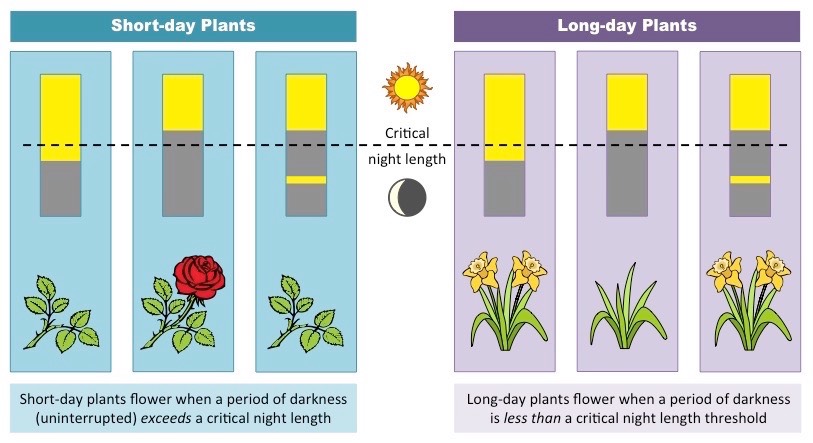![]()
Understanding:
• The switch to flowering is a response to the length of light and dark periods in many plants
The purpose of flowering is to enable the plant to sexually reproduce via pollination, fertilisation and seed dispersal
- Consequently, flowers need to bloom when pollinators are most active and abundant – this is dependent on seasons
- Some plants bloom in long day conditions (summer), whereas other plants bloom in short day conditions (autumn / winter)
The critical factor responsible for flowering is the length of light and dark periods, which is detected by phytochromes
Phytochromes
Phytochromes are leaf pigments which are used by the plant to detect periods of light and darkness
- The response of the plant to the relative lengths of light and darkness is called photoperiodism
Phytochromes exist in two forms – an active form and an inactive form:
- The inactive form of phytochrome (Pr) is converted into the active form when it absorbs red light (~660 nm)
- The active form of phytochrome (Pfr) is broken down into the inactive form when it absorbs far red light (~725 nm)
- Additionally, the active form will gradually revert to the inactive form in the absence of light (darkness reversion)
Because sunlight contains more red light than moonlight, the active form is predominant during the day
- Similarly, as the active form is reverted in darkness, the inactive form is predominant during the night

Photoperiodism
Only the active form of phytochrome (Pfr) is capable of causing flowering, however its action differs in certain types of plants
- Plants can be classed as short-day or long-day plants, however the critical factor in determining their activity is night length
Short-day plants flower when the days are short – hence require the night period to exceed a critical length
- In short-day plants, Pfr inhibits flowering and hence flowering requires low levels of Pfr (i.e. resulting from long nights)
Long-day plants flower when the days are long – hence require the night period to be less than a critical length
- In long-day plants, Pfr activates flowering and hence flowering requires high levels of Pfr (i.e. resulting from short nights)

![]()
Application:
• Methods used to induce short-day plants to flower out of season
Horticulturalists can manipulate the flowering of short-day and long-day plants by controlling the exposure of light
- The critical night length required for a flowering response must be uninterrupted in order to be effective
Long-day plants require periods of darkness to be less than an uninterrupted critical length
- These plants will traditionally not flower during the winter and autumn months when night lengths are long
- Horticulturalists can trigger flowering in these plants by exposing the plant to a light source during the night
- Carnations are an example of a long-day plant
Short-day plants require periods of darkness to be greater than an uninterrupted critical length
- These plants will traditionally not flower during the summer months when night lengths are short
- Horticulturalists can trigger flowering in these plants by covering the plant with an opaque black cloth for ~12 hours a day
- Crysanthemums are an example of a short-day plant
Flowering in Plants

